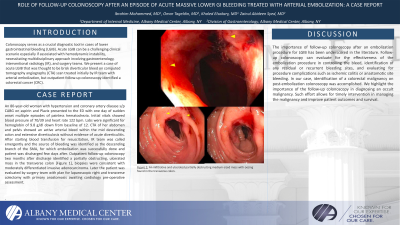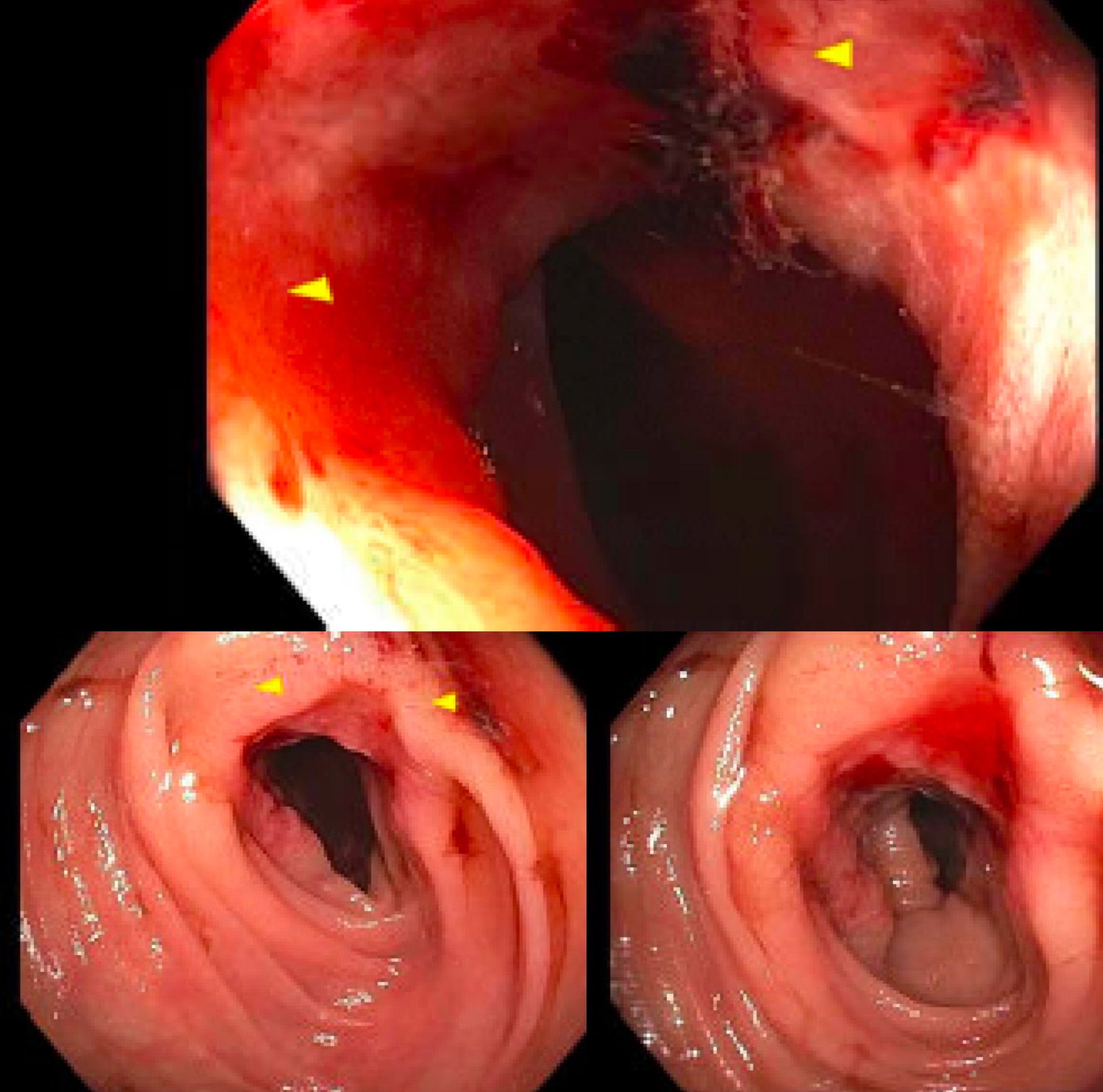Sunday Poster Session
Category: GI Bleeding
P0618 - Role of Follow-Up Colonoscopy After an Episode of Acute Massive Lower GI Bleeding Treated With Arterial Embolization: A Case Report
Sunday, October 22, 2023
3:30 PM - 7:00 PM PT
Location: Exhibit Hall

Has Audio

Ibrahim Mohammed, MD
Albany Medical Center
Albany, NY
Presenting Author(s)
Ibrahim Mohammed, MD, Omar Tageldin, MD, Khaled Elsokary, MD, Zainul Abideen Syed, MD
Albany Medical Center, Albany, NY
Introduction: Colonoscopy serves as a crucial diagnostic tool in cases of lower gastrointestinal bleeding (LGIB). Acute LGIB can be a challenging clinical scenario especially if associated with hemodynamic instability, necessitating multidisciplinary approach involving gastroenterology, interventional radiology (IR), and surgery teams. We present a case of acute LGIB that was thought to be brisk diverticular bleed on computed tomography angiography (CTA) scan treated initially by IR team with arterial embolization, but outpatient follow-up colonoscopy identified a colorectal cancer (CRC).
Case Description/Methods: An 80-year-old woman with hypertension and coronary artery disease s/p CABG on aspirin and Plavix presented to the ED with one day of sudden onset multiple episodes of painless hematochezia. Initial vitals showed blood pressure of 70/39 and heart rate 122 bpm. Labs were significant for hemoglobin of 9.8 g/dl down from baseline of 12. CTA of her abdomen and pelvis showed an active arterial bleed within the mid descending colon and extensive diverticulosis without evidence of acute diverticulitis. After starting blood transfusion for resuscitation, IR team was called emergently and the source of bleeding was identified as the descending branch of the SMA, for which embolization was successfully done and patient was discharged few days after. Outpatient follow-up colonoscopy two months after discharge identified a partially obstructing, ulcerated mass in the transverse colon [Figure 1], biopsies were consistent with moderately differentiated invasive adenocarcinoma. Later the patient was evaluated by surgery team with plan for laparoscopic right and transverse colectomy with primary anastomosis awaiting cardiology pre-operative assessment.
Discussion: The importance of follow-up colonoscopy after an embolization procedure for LGIB has been underscored in the literature. Follow-up colonoscopy can evaluate for the effectiveness of the embolization procedure in controlling the bleed, identification of any residual or recurrent bleeding sites, and evaluating for procedure complications such as ischemic colitis or anastomotic site bleeding. In our case, identification of a colorectal malignancy on post-embolization colonoscopy was accomplished. We highlight the importance of the follow-up colonoscopy in diagnosing an occult malignancy. Such effort allows for timely intervention in managing the malignancy and improve patient outcomes and survival.

Disclosures:
Ibrahim Mohammed, MD, Omar Tageldin, MD, Khaled Elsokary, MD, Zainul Abideen Syed, MD. P0618 - Role of Follow-Up Colonoscopy After an Episode of Acute Massive Lower GI Bleeding Treated With Arterial Embolization: A Case Report, ACG 2023 Annual Scientific Meeting Abstracts. Vancouver, BC, Canada: American College of Gastroenterology.
Albany Medical Center, Albany, NY
Introduction: Colonoscopy serves as a crucial diagnostic tool in cases of lower gastrointestinal bleeding (LGIB). Acute LGIB can be a challenging clinical scenario especially if associated with hemodynamic instability, necessitating multidisciplinary approach involving gastroenterology, interventional radiology (IR), and surgery teams. We present a case of acute LGIB that was thought to be brisk diverticular bleed on computed tomography angiography (CTA) scan treated initially by IR team with arterial embolization, but outpatient follow-up colonoscopy identified a colorectal cancer (CRC).
Case Description/Methods: An 80-year-old woman with hypertension and coronary artery disease s/p CABG on aspirin and Plavix presented to the ED with one day of sudden onset multiple episodes of painless hematochezia. Initial vitals showed blood pressure of 70/39 and heart rate 122 bpm. Labs were significant for hemoglobin of 9.8 g/dl down from baseline of 12. CTA of her abdomen and pelvis showed an active arterial bleed within the mid descending colon and extensive diverticulosis without evidence of acute diverticulitis. After starting blood transfusion for resuscitation, IR team was called emergently and the source of bleeding was identified as the descending branch of the SMA, for which embolization was successfully done and patient was discharged few days after. Outpatient follow-up colonoscopy two months after discharge identified a partially obstructing, ulcerated mass in the transverse colon [Figure 1], biopsies were consistent with moderately differentiated invasive adenocarcinoma. Later the patient was evaluated by surgery team with plan for laparoscopic right and transverse colectomy with primary anastomosis awaiting cardiology pre-operative assessment.
Discussion: The importance of follow-up colonoscopy after an embolization procedure for LGIB has been underscored in the literature. Follow-up colonoscopy can evaluate for the effectiveness of the embolization procedure in controlling the bleed, identification of any residual or recurrent bleeding sites, and evaluating for procedure complications such as ischemic colitis or anastomotic site bleeding. In our case, identification of a colorectal malignancy on post-embolization colonoscopy was accomplished. We highlight the importance of the follow-up colonoscopy in diagnosing an occult malignancy. Such effort allows for timely intervention in managing the malignancy and improve patient outcomes and survival.

Figure: An infiltrative and ulcerated partially obstructing medium-sized mass with oozing found in the transverse colon.
Disclosures:
Ibrahim Mohammed indicated no relevant financial relationships.
Omar Tageldin indicated no relevant financial relationships.
Khaled Elsokary indicated no relevant financial relationships.
Zainul Abideen Syed indicated no relevant financial relationships.
Ibrahim Mohammed, MD, Omar Tageldin, MD, Khaled Elsokary, MD, Zainul Abideen Syed, MD. P0618 - Role of Follow-Up Colonoscopy After an Episode of Acute Massive Lower GI Bleeding Treated With Arterial Embolization: A Case Report, ACG 2023 Annual Scientific Meeting Abstracts. Vancouver, BC, Canada: American College of Gastroenterology.
